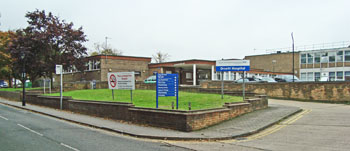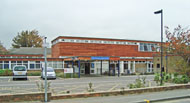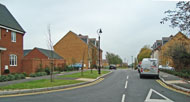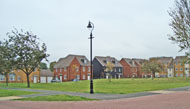Chronic sick. Later, acute and maternity. Later, out-patients only
In 1917 the Orsett Union workhouse, built in 1837, became the Orsett Lodge Hospital after the Essex Vagrancy Committee ordered that only sick paupers be admitted. The Hospital had an administrative block with a cruciform layout to the rear.
In 1930, following the abolition of the Board of Guardians, it was taken over by Essex County Council as a public assistance institution for the elderly chronically sick. It had 200 beds. In 1936 it was proposed to extend the Hospital to 250 beds.
At the outbreak of WW2 the Hospital joined the Emergency Medical Service (EMS) with 226 beds, under the control of the London Hospital. The facilities were upgraded and an extra 50 EMS beds were added. Most of the elderly patients were evacuated, but 23 remained. In November 1944 the Hospital reopened for civilian patients, when some 91 elderly people returned. Another 97 returned in March 1945 (50 of whom were originally from other hospitals).
After the war Dr Lionel Cosin was appointed as Medical Superintendent. He was a pioneer in the new specialty of geriatrics, seeking "to add not years to life, but life to years". Rather than allowing the elderly sick to become bedfast, he introduced physiotherapy to encourage mobility. Patients with fractured hips who had been referred for permanent care were treated surgically. The fractured hip was pinned, the patient mobilized, rehabilitated and discharged home.
In 1948 the Hospital joined the NHS under the control of the South East Essex Hospital Management Committee, with 227 beds.
In 1950 it became the Orsett branch of the Tilbury and Riverside General Hospital in conjunction with the Tilbury Hospital.
In 1953, although it was mainly a collection of old buildings dating back to the workhouse era, it was chosen to be the main general hospital for the Thurrock area to serve a population of about 70,000 people. However, the facilities were woefully inadequate.
The operating theatre - "a grim and dismal place" - was described as "less cheerful than a primitive morgue". It was also inconveniently situated; to reach it, patients would often have to be carried through the grounds in the open air, regardless of the weather.
The X-ray Department consisted of two units. The main one was as inconveniently sited as the operating theatre. The second X-ray machine, a mobile unit, had been placed in the Day Room of one of the wards, and ambulant patients had to walk through it to reach the toilets. If a patient was being X-rayed, the toilets were inaccessible - or if they were already there, could not leave until the X-ray examination was over.
The Out-Patients Department was cramped and uncomfortable, as was the staff accommodation.
In 1956 the Ministry of Health agreed that the Hospital needed to be rebuilt, at a cost of £1m. The major redevelopment scheme, to be financed by central government, was divided into two stages. Stage 1 included the building of new Out-Patients, Casualty and X-ray Departments, a 60-bedded maternity block, an operating theatre suite, a pharmacy, a Pathology Department and a Central Sterile Supply Unit, as well as new residential staff accommodation - 2 bed-sitter hostels for Sisters, 2 Nurses' Hostels and a bungalow for the Matron. Stage 2 included a new ward block with 203 beds, a 28-bedded ward as an annexe, and improvement of the existing wards. The Hospital would then have 344 beds to serve a population of 108,000 (it was estimated that it would grow to 120,000 by 1971). Extra staff accommodation would be built during Stage 2, as well as facilities for less urgent services.
By the 1960s the work had been completed and the Hospital had become a modern district general hospital with 227 beds for mainly acute and maternity cases.
In 1969 the Tilbury Hospital closed and all work was transferred to Orsett. The Hospital was renamed the Orsett Hospital.
In 1974, following a major reorganisation of the NHS, the Hospital came under the control of the Essex Area Health Authority, part of the North East Thames Regional Health Authority. It had 303 beds.
During the late 1970s the Hospital was further expanded.
In another NHS reorganisation in 1982, the Hospital came under the control of the Basildon and Thurrock District Health Authority. It had 527 beds.
In 1985 the Hospital had 510 beds. However, in the following year, the District Health Authority cut services to save money, and the maternity, gynaecological and children's surgery transferred to Basildon Hospital, some 8 miles away.
In 1991, when it had 474 beds, the District Health Authority decided to close the Accident & Emergency Department, despite public outrage. A new Minor Injuries Unit opened in a 'temporary hut'.
In 1994 the whole Hospital was under threat of closure, and a petition was presented to Parliament signed by 40,000 residents of Thurrock, requesting that the remaining Hospital facilities continue to be maintained and improved.
In 1998, despite fierce public opposition and the refusal of Thurrock Council to give planning permission, the Environment Secretary, John Prescott, granted consent for much of the Hospital site to be demolished for new housing.
In October the remaining five medical and three surgical wards closed. The in-patient services were transferred to a new ward block at Basildon Hospital.
In December 2002 a large part of the Hospital land was sold to Wilson Connolly, a housing developer, for over £20m. As a condition of the development of the site, it had been agreed that new hospital facilities would be built before any houses. The developers would also have to provide financial help for the provision of school places brought about by the increase in the school population caused by the new homes.
Much of the Hospital was demolished in 2004, but the surviving parts continued in use to provide out-patients services, clinical investigations, day surgery and treatment for minor injuries. Some £4m was spent on improving the facilities. A new eye clinic was established and an operating suite installed. The Sterilisation Unit, which provided services for the Basildon and Thurrock Hospitals NHS Trust, was upgraded.
Present status (October 2008)
The Hospital now provides only out-patient services on about a quarter of its original site. It is managed by South West Essex Community Services.
Update: March 2011
In May 2009 a £1m Renal Dialysis Unit with 10 haemodialysis stations opened on the first floor of the Hospital as a satellite unit of the Basildon and Thurrock University Hospital.
Update: January 2019
The Hospital is scheduled to close in 2020 or 2021 when new facilities have been built in Thurrock, Basildon and Brentwood.

The main entrance to the Hospital in Rowley Road.

The northern part of the Hospital.


The Out-Patients Department (left) and the John F. Bridgman Diabetes Care Centre (right) in School Lane.




New housing on the former Hospital site
(Author unstated) 1936 An Essex hospital survey. British Medical Journal 1 (3914), 78.
(Author unstated) 1961 Hospital building programme. British Medical Journal 1 (5222), 354-355.
Cosin L 1948 A statistical analysis of geriatric care. Proceedings of the Royal Society of Medicine 41, 333-336.
http://archive.chelmsfordweeklynews.co.uk
http://hansard.millbanksystems.com (1960)
http://hansard.millbanksystems.com (1986)
http://hansard.millbanksystems.com (1997)
http://seax.essexcc.gov.uk
www.basildonandthurrock.nhs.uk (1)
www.basildonandthurrock.nhs.uk (2)
www.bbc.co.uk
www.britishpathe.com
www.bygonegraysthurrock.co.uk
www.djdeloitte.co.uk
www.echo-news.co.uk (1)
www.echo-news.co.uk (2)
www.flickr.com
www.francisfrith.com
www.geograph.org.uk
www.harwichandmanningtreestandard.co.uk
www.nationalarchives.gov.uk
www.ncbi.nlm.nih.gov
www.pavitt4.fsnet.co.uk
www.theyworkforyou.com
www.thurrock.gov.uk
www.thurrockgazette.co.uk
www.workhouses.org.uk
www.yourthurrock.com
Return to home page